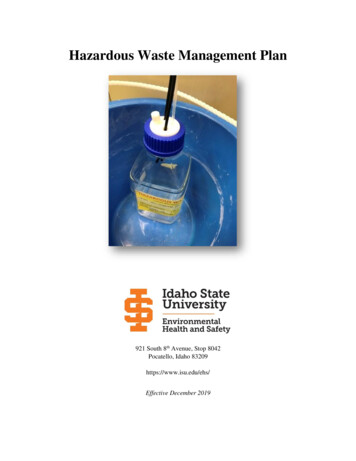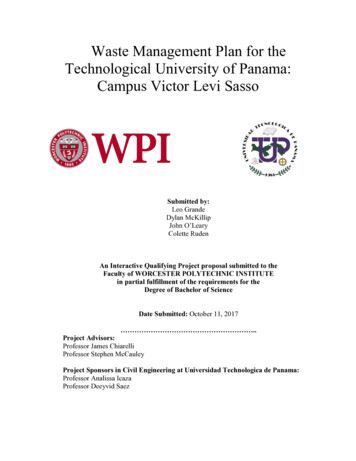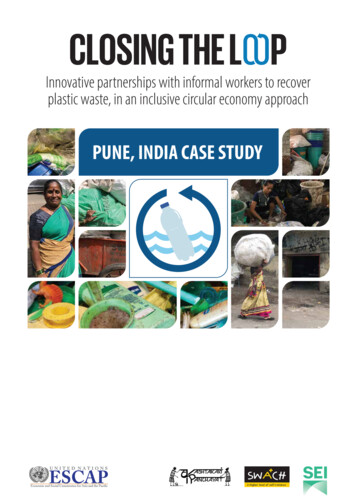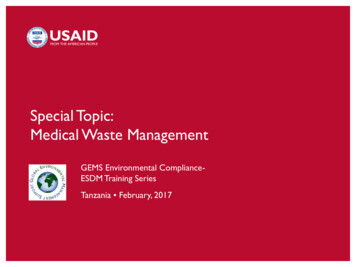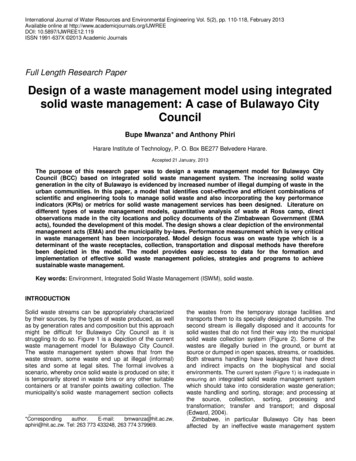
Transcription
International Journal of Water Resources and Environmental Engineering Vol. 5(2), pp. 110-118, February 2013Available online at http://www.academicjournals.org/IJWREEDOI: 10.5897/IJWREE12.119ISSN 1991-637X 2013 Academic JournalsFull Length Research PaperDesign of a waste management model using integratedsolid waste management: A case of Bulawayo CityCouncilBupe Mwanza* and Anthony PhiriHarare Institute of Technology, P. O. Box BE277 Belvedere Harare.Accepted 21 January, 2013The purpose of this research paper was to design a waste management model for Bulawayo CityCouncil (BCC) based on integrated solid waste management system. The increasing solid wastegeneration in the city of Bulawayo is evidenced by increased number of illegal dumping of waste in theurban communities. In this paper, a model that identifies cost-effective and efficient combinations ofscientific and engineering tools to manage solid waste and also incorporating the key performanceindicators (KPIs) or metrics for solid waste management services has been designed. Literature ondifferent types of waste management models, quantitative analysis of waste at Ross camp, directobservations made in the city locations and policy documents of the Zimbabwean Government (EMAacts), founded the development of this model. The design shows a clear depiction of the environmentalmanagement acts (EMA) and the municipality by-laws. Performance measurement which is very criticalin waste management has been incorporated. Model design focus was on waste type which is adeterminant of the waste receptacles, collection, transportation and disposal methods have thereforebeen depicted in the model. The model provides easy access to data for the formation andimplementation of effective solid waste management policies, strategies and programs to achievesustainable waste management.Key words: Environment, Integrated Solid Waste Management (ISWM), solid waste.INTRODUCTIONSolid waste streams can be appropriately characterizedby their sources, by the types of waste produced, as wellas by generation rates and composition but this approachmight be difficult for Bulawayo City Council as it isstruggling to do so. Figure 1 is a depiction of the currentwaste management model for Bulawayo City Council.The waste management system shows that from thewaste stream, some waste end up at illegal (informal)sites and some at legal sites. The formal involves ascenario, whereby once solid waste is produced on site; itis temporarily stored in waste bins or any other suitablecontainers or at transfer points awaiting collection. Themunicipality’s solid waste management section .zw,aphiri@hit.ac.zw. Tel: 263 773 433248, 263 774 379969.the wastes from the temporary storage facilities andtransports them to its specially designated dumpsite. Thesecond stream is illegally disposed and it accounts forsolid wastes that do not find their way into the municipalsolid waste collection system (Figure 2). Some of thewastes are illegally buried in the ground, or burnt atsource or dumped in open spaces, streams, or roadsides.Both streams handling have leakages that have directand indirect impacts on the biophysical and socialenvironments. The current system (Figure 1) is inadequate inensuring an integrated solid waste management systemwhich should take into consideration waste generation;waste handling and sorting, storage; and processing atthe source, collection, sorting, processing andtransformation; transfer and transport; and disposal(Edward, 2004).Zimbabwe, in particular Bulawayo City has beenaffected by an ineffective waste management system
Mwanza and Phiri.111Reuse/recyclingHouse ownersScrap ectionTransportationDisposalCollection binsMunicipalworkersMunicipal trucksCrude dumpingIllegal dumpingMetalSimple burningRubberCompostingGardenwastesWaste scatteringWaste spillageGases (CH4, NH3etc),leachate, litterEnvironmental health threats/risksWater, air, soil pollutionVisual intrusionPests, parasites, odours, diseasevectors-sanitationFigure 1. The Components of Solid Waste Management System in Bulawayo Municipality.which is visible by the levels of waste which is dumped inopen spaces. The research other concern was the lack ofdisciplin e in the way waste was dumped carelessly andthe lack of commitment for waste management by thecommunities. The main purpose of this paper is to designa waste management model for the city councils andother organizations involved in the management ofwaste. The characterization of waste into different types
112Int. J. Water Res. Environ. Eng.Figure 2. Illegal Dumpsite next to a Market (Mpopoma, 2011).will make it easy for the waste management agents tounderstand the main generators of waste and how it canbe stored, collected, transported and finally disposed of.The model is designed on the basis of different wastetypes generated from different sources of the community.The different sources considered are the differentresidential areas. In this study, waste characterizationstarts at the source to determine the type of wastereceptacle, waste collection method, transportation andthe best disposal method. The paper also recommendshow the city council or any organization involved in wastemanagement can improve the management of waste byincluding performance measures in the wastemanagement system.REVIEWED LITERATUREThe necessity for Waste Management cannot be overemphasized especially in modern society but it hasexisted for millenniums. In “Waste Management”Bilitewski et al. (1994) reports that from 9.000 to 8.000B.C. people learnt to dispose of their waste outside theirown settlement to avoid odor, wild animals and nuisancesof vermin (NIMBY SYNDROME). Waste management isnowadays far more complex than it was some thousandyears ago. The complexity arises not only because of thehuge quantities of residuals produced by the modernsociety, but also because of differences in thecomposition of the waste. Presently various municipalitiesfail to supply adequate waste management service totheir communities (Godfrey, 2006). This is shown by theincrease in uncollected waste in high density suburbs. Invarious places liter is scattered and also wasteaccumulates in non-designated places. One of the maincauses of poor service in most of the municipalities islack of proper planning although staff, equipment andpoor access to certain places are also given as reasons(Godfrey, 2006). The United Nations DevelopmentProgram survey of 151 mayors during the InternationalColloquium, in 1997, identified insufficient solid wastecollection and disposal to be among the five (5) mostsevere problems in cities worldwide (UNSD, 1999). Thisnumber shows the importance of well-functioning wastemanagement systems, and the necessity of makingimprovements in this field. If waste is unmanaged, itbecomes a source of contamination and disease(UNCHS, 1989). Proper waste management is needed toreduce health problems, water pollution risks and otherenvironmental hazards, besides the negative aestheticimpacts. Integrated Solid Waste Management (ISWM) ng, and disposal program (Figure 3). ISWMinvolves evaluating local needs and conditions, and thenselecting and combining the most appropriate wastemanagement activities for those conditions.The approaches in the area of solid wastemanagement are not only very capital intensive, but alsodifficult from the environmental and social points of viewtherefore, there is a need to develop, master andimplement a simple, but reliable tool that will help thedecision makers in the analysis process. IntegratedMunicipal Waste (IMW) model (Figure 4) is a tool whichseems to meet all the requirements (White, 1997;Bjorklund, 1998; Eriksson, 2002; McDougall, 2001). Theresults of the analysis from the IMW (Figure 4) modelgive vast amount of information, but it is ratherfragmented. Waste management is in itself a large andcomplex system that is difficult to survey. The systemgrows even more complex as one considers its links toother sectors such as manufacture, energy production,and agriculture. Based on this reviewed model and othermodels, the author proposes a model that is easy tounderstand and that will also be easy to convert into a
Mwanza and Phiri.113Figure 3. Integrated Solid Waste Management System (www.epa.gov/globalwarming).Figure 4. IWM Waste Management Model (www.plastics.ca/epic).database that can be used by the waste managementagents considering the level of technology. The modedesigned in this paper gives a broad presentation of theimportant elements necessary in the management ofwaste. The major findings of this paper are that the modelwill enable monitoring of waste types from each location
114Int. J. Water Res. Environ. Eng.and help set targets for waste minimization.MATERIALS AND METHODSQuantitative analysisAn analysis of the amount and types of waste generated wasconducted at Ross camp. This analysis was conducted todetermine the amount of waste generated per week by a populationof 483 people. Ross camp is a community that consists of 77households and each house was given a task of accumulating theirdaily domestic waste for a week.The amount of waste that was generated was analyzed in termsof the type of waste, the type of waste receptacles; separation atthe source was also analyzed to determine whether the residentsknew about waste separation to account for waste recycling. Theamount of waste that was generated in a period of 7 days wascalculated and the results are shown in Table 1.This analysis was done to determine the amount of waste andtypes of waste that is generated by households as the researchwas more to do with domestic waste.density areas, provision of waste receptacles in some householdsis there but the concern was on the collection regularity and timemanagement by the city councils. During these trips, besides takingnotes about the physical characteristics of the neighborhoods,photographs were taken to show and record illustrative featuresand interesting attributes of the areas.RESULTSWaste management models are getting increasingattention throughout the world. It is therefore important tounderstand possibilities and limitations of differentmodels. This section covered the design of theconceptual model for Bulawayo City Council IntegratedSolid Waste Management Model (Figure 5) based on thereviewed models, (Figures 1 and 3) and data that wascollected from the case study at Ross camp.Case study resultsData collectionThe purpose of this research was to design a waste managementmodel for Bulawayo City Council and information that wasnecessary for the design of the model was collected. Literature froma number of waste management models was reviewed. Informationpertaining to the environmental management act concerningmanagement of domestic waste was also reviewed. Thisinformation was reviewed to assist in the design of the new modelusing integrated solid waste management system.InterviewsInformal interviews were conducted at Ross camp as it was thestudy area. The structured questions during the interviews focusedon the following:(i) The importance of waste management(ii) The causes of increase in waste generation.(iii) The methods of waste collection.(iv) The types of waste receptacles used.(v) The frequency of waste disposal.(vi) Their understanding of waste separation at the source and if itis being practiced.(vii) The effectiveness of the waste management company(viii) Waste recycling(ix) The role of the public in terms of waste management(x) The impact of poor waste management.These questions were structured as an improvement process onthe waste management model of Bulawayo City Council and also tofind out the views of the residents on waste management.ObservationsThe researcher made tours in the different locations of Bulawayo.During those tours, it was observed that the community especiallyin the high density suburbs, carelessly disposed wastes anywheredepicting illegal dumping. Observations made in the city center,confirmed a different perception people have towards waste. Somepeople would use the bins and some did not. Coming to the lowTable 1 shows the results that were obtained from thestudy conducted at Ross camp to determine the wastegeneration rate. In this study, waste was collected fromthe 77 houses that make up Ross camp after a period of7 days. The rate of waste generation in Ross camp inBulawayo is 0.00024 m 3 per capita per day (Table 1).During this study, no waste receptacles were provided forthe households as the study also focused on the type ofreceptacles the residents used. The waste componentsfound in Ross camp included food residues, paper,plastics, metals, glass, textiles, rubber, and wood. Theresults obtained from Ross camp on waste compositionare shown in Table 2.From Table 2, the sampled households reflected a totalweekly waste generation of 8.06 m3 (8060 L). This gives amean weekly waste generation of 0.010 m 3 perhousehold. The daily per capita waste generation isestimated at 0.00024 m3/capita/day. The value is farbelow; this may be due to the fact that the study at Rosscamp focused on domestic waste only.The case study (Table 3) shows the type of wastereceptacles which the households use for waste storage.According to the case study, 73% of the households usemakeshift (sacks, tins, buckets, plastics), 19% use properbins provided by the city council and 8% have noreceptacles.Residents whose households do not pay for wastecollection services ended up disposing their waste inopen spaces, rivers, and drainage basins (Figure 1),burning or burying it. In this study, it was observed thatwaste collection is done once every week for thosehouseholds that pay for their waste to be collected.The factors that influence the amount of wastegenerated are;(i) The time of the year: mainly holidays of the year, thatis, Christmas and New Year holidays.
Mwanza and Phiri.Table 1. Summary of the calculation of the per capita waste generation.VariableNumber of householdsPopulation3Total weekly waste generation(m )Weekly per capita waste generation (m3/capita/week)Daily per capita waste generation (m3/capita/day)Sample774830.8060.806 m3/483 people 0.001670.00167/7 0.00024Total study area770770*6 46200.010*770 8.060.001670.00024Various SuburbsDomesticGeneratorsWaste TypesINTEGRATED SOLID WASTE MANAGEMENTWaste Storage and HandlingBlack-refuseBagsHard plastic binsSimple-emptyingWaste CollectionCurbsideWaste TransportationTrucksMaterial RecoveryRecyclableMaterialsHouseholds/recycling PlantsFigure 5. Conceptual Model of BCC ISWM.BiologicalCompostThermalEnergyFig 4.1: Conceptual Model of BCC ISWMSanitary Landfill115
116Int. J. Water Res. Environ. Eng.Table 2. Waste Composition table.Waste compositionFood remainsPlasticPaperYard wastesGlassMetalTotal%23423040.40.6100Table 3. Type of Receptacles used for daily collection of waste.Type of containerNo binsMakeshift (sacks, tins, buckets, plastics)Proper bins (provided by BCC)%87319(ii) The rise in residents’ earnings. (iii) Month-endsearnings.The findings from the study also showed that wasteseparation at the source is not practiced by thosehouseholds whose waste is collected by the wastecollectors. The case is even worse for those householdswhose waste is not collected. From this study, wasterecycling is not practiced by the residents and in anycase, if waste recycling was being practiced by the wastecollectors, then separation at the source would havebeen promoted and the residents would have fullknowledge about waste recycling. Disposal of waste byresidents whose waste is not collected is done on a dailybasis and mostly consists of open space disposal andburning.The information that was obtained from the case studycontributed to the design of the model.bridge the gap in the current BCC model. The researchertherefore classified each waste type with a suitable wastereceptacle. The different types of waste can be storedand collected differently (Table 4). Once the waste isseparated at the source and stored in specific wastereceptacles, it will be easy to transport waste to thedesignated disposal area. Other than disposal, waste canbe treated by various ways to recover material. Thisincludes energy recovery from industrial waste, compostfrom bio-gradable waste and recycling by bothhouseholds and industries.Bulawayo City Council as a waste managementauthority should comply with the regulations on wastemanagement. The municipality has a department whichmanages waste and this department should comply withthe acts and laws which have been put in place. TheModel is designed by linking it to the environmentmanagement act and the city by-laws as compliance tothe regulations. All the regulations in the environmentalmanagement act pertaining to the management of wasteshould be considered by Bulawayo city council otherwiseit will be contravening the act.The designer of the model included the EMA acts andthe city by-laws in its waste management to show thatBCC acknowledges the acts and by-laws.This model provides a clear understanding of wastemanagement process. The waste type characterizationmakes the waste recovery section easy as there will beno need for waste separation. The uniqueness of themodel is that it shows;(i) The type of waste generator.(ii) The type of waste generated.(iii) The type of waste receptacles.(iv) The type of collection method.(v) The type of transportation.(vi) The type of disposal method pertaining to a wastetype.This model does not only reflect that the EMA isarticulated, but it has included some performancemeasurements on the collection of waste which is part ofwaste management.Model designThe researcher conceptualized the system based on thefact that waste is generated from different sources andthis waste is of different types depending on where it isbeing generated. The different sources of waste inBulawayo town are the residential areas, industries,commercial areas, institutions, farms and constructioncompanies etc. but the focus is on residential areas.These sources generate different types of waste whichcan be categorized into domestic waste, industrial waste,toxic waste, biodegradable waste etc. Waste types canbe handled, stored and transferred differently. Eachwaste type can be separated at the source if the wastereceptacle is determined. Separation at the source willStrengths of the model(i) EMA acts and the municipality by-laws are depicted inthe model showing that BCC abiding by the regulationsand also showing a sense of responsibility pertaining towaste management.(ii) Performance management is very critical to wastemanagement and for this reason the system has beendesigned with an aspect of performance management onwaste collection.(iii) Knowing the different types of waste is relevant in thissystem as the system is designed in such a way thatwaste type is the determinant of the waste receptacles,collection, transportation and disposal method which
Mwanza and Phiri.117Table 4. Waste Receptacle and collection uralCommercialInstitutionalWaste generatorHouseholdsIndustriesChemical plantsFarms, VineyardsRestaurants, stores, hotelsSchools, colleges, prisons, hospitalsWaste receptacleBlack refuse bags, Hard plastic binsSkips, metal binsSkips, metal binsHard plastic binsHard plastic bags, plastic binsMetal bins, Hard plastic binsmakes it easy for learners to understand the use of themodel.(iv) Material recovery is important and this model showsthe different ways in which waste can be recovered.DISCUSSIONWaste Management acts are not fully been complied toby the city council and the community and this promptedthe author to come up with a design of a model whichincorporates the EMA acts as part of the driving force inwaste management. The fact that waste is dumped inillegal dump sites and also the results from the interviewsalso contributed to the conclusion that EMA acts are notyet totally in place, and more time is needed formunicipalities to be able to comply with the regulations.(EMA act is in place but no compliance)There has been little pressure in the past for providersof solid waste management services to evaluate servicequality, improve standards of performance or to justifyservice quality relative to its cost (Michael, 2008). Thismodel has integrated performance measurement as anevaluation method for BCC Departments’ managementinformation systems. In practice this means establishinga reporting system on the performance of the SWMservices, and routine collection of information (daily,weekly, monthly, yearly).The results and picture (Figure 2) from the surveysshow that there is no waste characterization especially inthe communities and this model shows that wastecharacterization is the drive towards easy wastemanagement as it draws a line between different types ofwaste and waste generators. This strategy ofcharacterization of waste in terms of waste generatorswill help waste managers to manage the types of wastethey are dealing with and how best to recover, recycleand finally dispose of it.This model is a start to the design of a databasesystem for the city council and other waste managers. Itis a framework or skeleton for the design of a database.RECOMMENDATIONS AND CONCLUSIONThe model designed will require a design of a databaseCollection methodCurbside, informal, Simple-emptyingOne-way, non-systematicExchange, one waySimple emptyingSimple emptyingSimple emptyingfor it to be fully appreciated in its capacity for managingwaste. The results show that this waste managementmodel can be useful at a number of different levels insociety. For example, it can be used by companies tosupport strategic decisions, by municipalities for wastemanagement planning, and for governments for policydecisions. The researcher also recommends that BCCstarts waste recycling projects by incorporatingresidential areas as the main source of collectingrecyclable waste which is separated at the source. Forthis to be made possible, households should be providedwith waste receptacles. BCC does not have to chargewaste collection charges for those residents whoseparate and store the agreed amount of recyclablewaste on its behalf.ACKNOWLEDGMENTSThe authors are grateful to Eng. Phiri and Mr. N. Chirindafor offering the right guidance regarding this researchwork and helping to improve the paper as preciously aspossible.REFERENCESBilitewski B (1994). Waste Management. Berlin Springer-Verlag. pp. 1020.Bjorklund A (1998). Environmental Systems Analysis WasteManagement with Emphasis on Substance Flow and EnvironmentalImpact. Stockholm University of Technology, Sweden. pp. 10-21.Edward DA (2004). Integration of municipal solid waste management inAccra (Ghana): Bioreactor treatment technology as an integral part ofthe management process. Lund University pp. 10-12.Eriksson O (2002). ORWARE- A simulation tool for waste managementResources, Conservation and Recycling. Res. Gate pp. 15-40Godfrey L (2006). Integrated waste management plans: A usefulmanagement tool for local Government or a bureaucratic burden.Biennial Waste Conference Proceedings 2006, Cape Town, SouthAfrica.McDougall F (2001). Integrated Solid Waste Management. A Life CycleInventory. Blackwell Publishing, pp. 10-15.Michael EV (2008). Performance Measurement of the BinghamtonUniversity Waste Management System. State University of New York,USA, pp. 10-12.Small scale waste management models for rural, remote and sets/pdf/pn 1260 e.pdf(accessed26/07/2011).
118Int. J. Water Res. Environ. /www.epa.gov/global warming (accessed 22/05/2011).UNCHS (1989). Solid Waste Management in Low-Income HousingProjects. The Scope for Community Participation. Nairobi.UNSD (1992). Environmentally Sound Management of Solid Wastesand Sewage. Related Issues. [Online]. [United Nations g/esa/sustdev/agenda21.htm [2011, June 6].Whiteman A (2001). Strategic Planning Guide for Municipal SolidWaste Management . Integrated solid waste management in westernAfrica. pp. 337–353.
management of domestic waste was also reviewed. This information was reviewed to assist in the design of the new model using integrated solid waste management system. Interviews Informal interviews were conducted at Ross camp as it was the study area. The structured questions during the interviews focused







